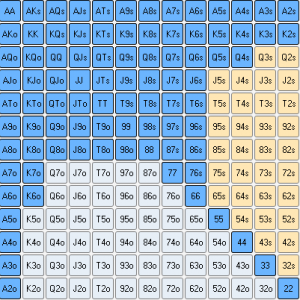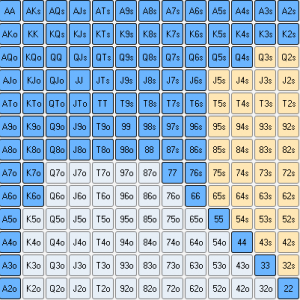In order to further our development as poker players, it’s often necessary to conceptualize certain parts of the poker experience in ways such as they are most useful to us, as opposed to more obscure forms that may be more easily mathematically provable or identifiable. In plain English – rather than numbers on a calculator, some poker concepts exist as broader, more psychological phenomena which are hard to calculate, but can be easy to apply.
The concept of range differentials is one of those concepts. It’s hard (but not impossible, if you have a GTO solver to hand) to use this concept mathematically, because it relies on an in-game perception of our opponent’s specific thought processes, but you’ll probably find yourself using this concept almost every single time you play. To my knowledge, the concept hasn’t yet been clearly defined by another poker writer – in which case, this article serves as my claim as its architect.
 What is a range differential?
What is a range differential?
A range differential is, very simply, the difference between what your opponent thinks your range is in a given spot, and what your range actually is. It’s the space between what’s really happening, and what a player thinks is happening. This differential might occur on a very simple level – a weak player thinks his opponent has Ace-King, but they actually would have played Ace-King very differently – or on a very complex level, where two high-level professionals play a heads-up match and the winner is the one who is able to manipulate range differentials most effectively.
Range differentials are, essentially, the number one driver of all profit occurring in poker. If our actual range in every spot was exactly the same as what our opponent thought we had, we would never make any money. Conversely, if our ranges were so unpredictable that we always misled our opponent and they always thought we were bluffing when we had value or always thought we had value when we were bluffing, we’d make a lot of money.
We can even posit the existence of a ‘secondary differential’ – that is, the difference between the range differential from our perspective (our real range compared to our perceived range), and from our opponent’s perspective (our opponent’s real range versus what we perceive their range to be). If our range differential is positive, i.e. our opponent isn’t very good at understanding our ranges, while our opponent’s differential is negative, i.e. we have a very accurate understanding of their ranges (perhaps even a more accurate understanding than they do), this creates a massive edge for us.
A few examples
Let’s look at a few examples to make this concept a little clearer:
- We defend the big blind in a live game versus a late position raise and the flop comes A-9-4 We know our opponent doesn’t two-barrel these flops very often, so we decide it’s a pretty good idea to float this flop out of position with Q-J (and other similar hands), with the intention of bluffing the river and repping the Ace if villain checks the turn. Villain does check the offsuit 7 turn, and when the river comes a 2, we follow through with our plan to bet. Villain folds and shows us KK, and says, “I guess you had the Ace, huh?” – we don’t reply. Here, our opponent thought our range on the river contained mostly Ace-x hands, so we took advantage of that by bluffing with a high frequency.
- We raise in early position with AA in a full ring game. The villain defends the big blind, and the flop comes J-T-9 with a flush draw. Villain checks, we bet, and villain calls. The turn is a Q, bringing the third flush card. Villain checks again, and we decide that since we don’t have the Ace of the flush suit, this might actually be a good spot to turn our hand into a bluff. We can probably get the villain to fold an 8 sometimes, and two pair almost always, since it’s so easy for us to have a King. We bet, and villain does fold. In this spot, the differential was between villain’s expectation that our turn betting range would include almost no bluffs (since so many hands in our range have either a straight, two pair or a set, some of which wouldn’t bet), and the reality that we were capable of turning an overpair into a bluff.
- We raise under the gun in a full ring game with 77 and get called in middle position. The flop comes 7-5-3 with a flush draw. We decide to check, and our opponent, sensing weakness, bets. We check-raise with our top set, and since villain expects that we would never check a strong hand on this flop for fear of our opponent checking behind and taking a free card with a draw, villain assumes our range is mostly composed of flush draws. In an effort to get maximum value from our draw, villain goes all-in with 99, and we snap him off. Here, the differential was between our value-heavy check-raising range on that flop, and villain’s assumption that we would never check-raise a strong hand.
Using differentials effectively
The key to using differentials effectively in most spots is simply to have a highly-developed understanding of the two parameters involved – what our range actually is, and what our opponent thinks it is. By accomplishing these two things, we can then create a large secondary differential – our differential is bigger than our opponent’s, and we understand and respond to their ranges better than they understand and respond to ours.
The best way to get to this point is by doing the two things that are most useful in helping us to learn more about our opponents’ ranges – playing more, and studying more. In particular, we need to be studying hands in a way that takes note of what our opponents end up actually having in a certain spot, so that we can try to reverse engineer their thought processes – you might try searching your Holdem Manager or PokerTracker database for all the hands that went to showdown on the river, for example.
Differentials and GTO/Exploitative Play
Finally, a word about how range differentials fit into the GTO/exploitative continuum. Obviously these ideas fall more on the exploitative side, since we’re looking at understanding ranges in practicality rather than theoretically perfect ones. However, there is a GTO application of the concept, in that if we’re trying to play close to GTO ourselves, our main source of profit comes from the difference between our the GTO way to play a certain spot, and the way our opponent actually plays it – you could call this a ‘GTO range differential’.
The conclusion that we can come to, therefore, is that no matter which paradigm you’re operating in, range differentials are an important concept to get to grips with – asking yourself in each situation, “what’s the differential here?”, or even just “how strong does my range look here?” is a great start on the path towards playing better poker. We don’t always have to be able to run calculations in order to evaluate our thought processes.



